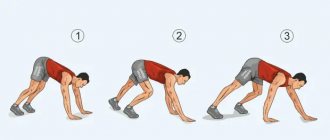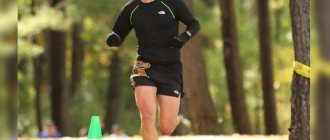Hello, friends!
If you're not completely new to running and are ready to tackle a challenging distance, try running a 10K. Such a distance requires not only strength, but also speed and willpower. While running, fat reserves are reduced, joints are strengthened, and sugar and cholesterol levels are reduced. What's not the motivation to try this sports discipline?
A person has a physical limit called “reaction speed”. Running 10 kilometers is a step towards “reaction speed”.
If running is easy, you can limit your running time to 52 minutes. If you have covered this distance, you must reduce the time.
Try to increase your results every day.
Running 10 km without training seems like an insurmountable obstacle. You need to prepare for this not only physically, but also mentally. Sit down and think about the distance, possible obstacles and, most importantly, realize that you need it!
Also when running: 1/3 of the distance you can run fast, 2/3 you are running moderately, then in the last third your body tells you to slow down.
Since we need to run for a long time, and we are tired and believe that this is not enough, we did not cover this distance in vain.
Mental strength is a necessary component when you run, especially over 10 kilometers.
Of course, running affects the respiratory system. A developed respiratory system will help in the future, other activities and hobbies.
It's about proper breathing. When we are tired, the intensity of breathing increases, the body requires a lot of oxygen. In the final stages, when it is already difficult to breathe, “hardening” of the lungs appears.
Running 10 km standards for men and women
10 km running is a long distance athletics discipline. It can be carried out in a stadium, highway and rough terrain. Included in the Olympic Games since 1912, and for women since 1988.
Men's 10 km running standards
| Titles, ranks | Youth | ||||||||
| View | MSMK | MS | KMS | I | II | III | I | II | III |
| At the stadium (400 m lap) 10 km | 28:06,0 | 29:25,0 | 30:35,0 | 32:30,0 | 34:40,0 | 38:00,0 | — | — | — |
| By highway 10 km | — | — | — | 32:50,0 | 35:00,0 | 38:20,0 | — | — | — |
Women's 10 km running standards
| Titles, ranks | Youth | ||||||||
| View | MSMK | MS | KMS | I | II | III | I | II | III |
| At the stadium (400 m lap) 10 km | 32:00,0 | 34:00,0 | 35:50,0 | 28:20,0 | 41:30,0 | 45:00,0 | — | — | — |
| By highway 10 km | — | — | — | 38:40,0 | 41:50,0 | 45:20,0 | — | — | — |
How much should you run per day?
A kilogram of fat is equal to 7700 kcal, but it is impossible to burn such an amount in 2-3 workouts. But there are certain features of calculating how much you need to run per day to lose weight:
- to burn 2 kg you need to run 290 km, which is equivalent to almost 2 months of training at 5 km a day or 1 month at 10 km;
- it is important to remember the rule of fat burning, if a woman weighs more than 68 kg, then you can lose up to 1 kg per week, and if less, then no more than 450 g;
- You need to achieve a deficit of 500 calories per day, but no more, otherwise you won’t have any energy left for training.
If you run incorrectly and allow a big difference in your calorie deficit, you can get injured. Deficiency also provokes stress, which creates a risk of breakdown.
You should not chase the numbers on the scale, as intensive weight loss is dangerous for the body and psychological state. The lost kilograms come back faster the more actively they go away. If a person intellectually recognizes the need to lose weight, changes his lifestyle and dietary rules, then he loses weight slowly, but for a long time.
10 km running record
The world record in the 10 km race among men belongs to the Ethiopian Kenenisa Bekele, who ran this distance around the stadium in 26:17.53 m in Brussels in 2005.
In road running, the world record belongs to the Kenyan Leonard Komon, who covered 10 km in 26:44 in Utrecht in 2010.
The world record holder among women is Ethiopian Almaz Ayana, her result at the Rio Olympics in 2016 at the stadium was 29:17:45 m.
In road running, the world record is held by Englishwoman Paula Radcliffe. Her result was 30.21 m, which was recorded in 2003 at the London Marathon.
Calculating weekly mileage
So, we got to the most interesting part: how much running volume should an athlete do for a marathon, half-marathon and “ten”?
Long run percentage
First, you must understand that mileage depends on the amount of training.
The more often you run, the more varied your workouts, and the smaller the percentage of long, slow runs.
Here are the approximate numbers:
- With daily running, long runs account for 23-30% of the weekly mileage;
- When running 5-6 times a week: 25-35%;
- 3-4 times a week: 35-50%.
Making a training plan
Preparation for a 10 km run should combine the development of speed and endurance. Start training at least 4-6 weeks before the race to complete the entire training plan. The main goal is to develop basic physical qualities: general endurance, pure strength and speed.
The training plan is usually drawn up according to the following algorithm:
- Selecting the starting distance. It should be as comfortable as possible, that is, one that can be run without interruptions at a slow pace. After jogging, do some stretching in the first workout and run another quarter of the designated number. Half of the distance determined at the beginning is added to the second workout.
- Regularly increasing the distance. After 2 workouts, continue the race at 1.5 comfortable distances without breaks. Slow pace, good breathing and a mildly stressful workout. You no longer return from classes invigorated.
- Continue to increase the distance. After mastering a new distance, each time add a new segment of ¾ of the already mastered length. Increase the race to 4 km, then add 1 km each for several weeks. Each stage is worked out to good quality, when there is no shortness of breath and there is no need for a long rest break.
- Subsequent build-up. By adding 1 km at a time, bring the distance to 10 km. Now the work on timing and changes in running structure comes into play. This means running a distance faster, with acceleration, deceleration, and developing tactical thinking.
Important! It is advisable to keep records of your times in order to know the time of running the distance.
The optimal period of preparation for a 10 km race is 12 weeks, the minimum is 6 weeks.
Features of the training process
The 10,000 meter race is run at a less intense pace than the 5,000 meter race. However, the first one requires twice as much time to overcome it. Therefore, a distance of 10,000 meters requires the development of special endurance, which allows you to maintain a relatively high pace over a long period of time.
Unlike the 10,000 meters, the 5,000 meters is run at almost the IPC level. Lactate levels rise much faster and in the last part of the distance reaches values at which maintaining a high pace becomes a very difficult task. Therefore, the 5,000-meter race is considered a more difficult discipline. It is not surprising that almost all runners who specialize in the 5,000 meters also compete in the 10,000 meters.
marathon and half marathon training plans and start training today!
The training plan for 10,000-meter runners should focus on developing aerobic power, increasing anaerobic threshold (ATT), and increasing running economy.
10 km training program
Training begins with working out the basic indicators - proper breathing and endurance.
The main 4 principles of the training program:
- Regularity - the drawn up program must be carried out strictly, no matter what the circumstances.
- Warm-up – do simple warm-up exercises for 10-15 minutes, working the tendons, muscles and joints. This will help avoid injury and make for a quality workout.
- Cool down – carried out at the end of the workout. It means gradually slowing down your workout, followed by stretching. This will help the muscles recover faster.
- Proper nutrition and sleep - they also help restore the body's reserves. Thanks to them, the rate of indicator development grows faster.
Rules for running for weight loss
When drawing up a schedule, it is important to consider not only how much you need to run per day to lose weight, but also the characteristics of the load.
In 1 minute of jogging at a comfortable pace, an average of 8.5 calories is burned, or 255 calories per half-hour workout.
However, starting exercises with 30 minutes of intense running is strictly prohibited. It is also important to consider rules such as: mandatory warm-up before the marathon and a gradual reduction in calories burned.
That is, in the first weeks of regular running, more body fat and calories consumed will be burned, but with each month they will decrease. Gradually, the body adapts and running will only help maintain shape, but not get rid of accumulated reserves.
Exercises to develop muscle strength
Muscle strength plays an important role, it affects endurance and speed. Runners are not very fond of strength training and put it off until the last minute. On the one hand, the athlete must strengthen the most commonly used muscles: the hips, calves and hamstrings, but the core and upper body are equally important. Therefore, strength training days should be included in the schedule.
The most effective exercises for runners:
- Plank is a great way to strengthen your core and shoulder muscles. It comes in classic and side styles. In the latter option, the abs are actively trained.
- “Russian twist” (torso turns) - affects the abs, back and hamstrings.
- Lunge squats with arms raised - hips, glutes, knees, shoulders and core. They can be performed with weights.
- Air squats are a must. The thigh, buttocks and core muscles are fully worked out. The emphasis should not be on the toes, but on the heels. It's like you're sitting on a small chair. To prevent socks from being involved, you can place dumbbell pancakes under them.
- The single-leg deadlift is an ideal exercise for hamstrings, glutes, balance, and stability.
- “Pistol” - leads to severe muscle soreness such that it can be painful to walk.
- Dumbbell Rotation Raises - Strengthen your upper body.
Important! After strength training, it is useful to hang or do pull-ups on the horizontal bar. This relaxes the spine.
Interval running for beginners
Interval training involves alternating intense running and walking for 30 minutes. This way you can get the most out of your workout by burning more calories. Its benefit also lies in the fact that even during rest, when a person walks, he continues to intensively burn calories.
Features of this run:
- speeds up metabolism;
- tones the body, strengthens muscles and burns excess fat;
- can be preparation for competitions.
The difficulty with this kind of running is the increased feeling of hunger after training. The main thing is to control yourself and not try to eat a lot of food after class.
Strategy and tactics for a 10 km distance
In long-distance running, tactics are important for any athlete; here it consists of evenly distributing force over the entire distance. Speed is calculated during training .
For example, you calculated that to run 10 km you need 50 minutes, that is, 5 minutes are spent for each kilometer. Deviations from the pace should be insignificant - 1-3%. You can’t rush even on the first kilometer.
After the first 5 km, evaluate the possibilities - run further at the same pace or add no more than 1.5-2% pace at each kilometer. At 8-9 km it makes sense to run a little faster - this is a run 1-2 km before the finish.
Don't forget to drink water during and after the race. Clothes should be appropriate for the weather: shorts and a T-shirt or a track suit - the result also depends on this. During the distance, the muscles should not be tense , otherwise they will not work fully. The athlete must mentally check the tightness of the muscles every kilometer - arms, legs, neck and back. If necessary, relax them, but maintain the pace.
Common mistakes:
- Fast start. The runner runs the first 2 km in 9 minutes instead of 10. As a result, he will choke and can only crawl to the finish line. You can’t focus on those running in front; everyone has their own pace.
- Early finish - after running half the distance, some runners begin to speed up, believing that the finish is already close. So you can drive yourself into such intensity that after 2-3 km you simply run out of steam. You should only start accelerating if the selected pace is too slow or there are no more than 2 km left to the finish line.
New goals
I’m not thinking about a marathon yet: the loads are too extreme and the training process is difficult to fit into my life. I’m counting on a half marathon next year, since I’ve already run 12 km and I feel that within a year I’ll increase the distance to 20 km. But I won’t increase the pace above 5 minutes/km: the heart rate at 4 minutes/km rises to a critical 180 beats.
And one more unexpected effect: flat feet and valgus deformity (bone on the joint) of the big toes are reduced. I attribute this to the fact that I run on my toes. Another advantage of such running: the muscles and ligaments of the arch of the foot are trained, due to the weakness of which these defects arise. I still have pictures from two years ago (and I’ll compare them in another five years), but my fingers are visually returning to their place.
So running has added only positive emotions to my life, and I wish the same for you. And yes, greet each other while jogging! We are the chosen ones, in the sense that we have chosen the right path. 
Modern bicycles and distances
A bike with amazing suspension, reliable braking system and gears can handle a distance of 50-60 km. And this is on an asphalt, flat road. A cyclist on such a horse can easily cover less distance in a few hours. Amateurs, namely city residents, often organize similar runs with friends, trying to think through the route in advance and return home before sunset. But how long do you travel, say, with your spouse or friend? This question is often about age rather than technique.
A classic that is always in our memory
What about the Ural or the Chinese Skif? What is this technology capable of? The distance that can be covered during the day depends on several factors:
- Bike condition.
- Moral and physical attitude of the cyclist.
- Route.
Sometimes even on such seemingly useless units, they cover up to 40 km by midnight. This is not difficult to achieve; it is enough just to get lost in the thicket of the forest, and after a while a person gets a second, and then a third wind. Asphalt, rural sandy road, ditches and all the other riches of the road system are invisible if the sun is setting, and it’s still a long drive to get to your home or dacha.
Of course, you won’t be able to go hiking on bicycles using Soviet technology, but repairing such a vehicle is very easy, even for a schoolchild. You can drive no more than 15 km on any road without getting tired, because speed alone does not relieve your legs. And this is important for the process.
We increase personal indicators correctly
The usual speed for a modern bicycle is 15-20 km/h. It turns out that the usual 50 kilometers is not that long. However, here it is important to stay in good shape upon arrival, because it’s exactly the same time home, and a taxi or ride is unlikely to give you a lift.
To avoid such stupidity, it is advisable to take your equipment out for a walk every day for 30-40 minutes. Then it will be more common to walk a distance of 50 km, and then it’s not far from a hundred. What’s interesting is that the figure of 100 km itself is a psychological bar that often frightens rather than represents a real difficult task for the cyclist. Think about it: we drive 50 km along the highway, rest, have a snack and return to the city. This is the same 100 km, but with the standard already met.
To increase the distance, it is easy to make several stops, but not for rest, but more to tune in to the distance. Then it will be a joy to walk 140 km with the whole group. But health is much more important, because bicycles that are not configured correctly are not “for you” - this is a dangerous thing for your joints. There is a possibility of damaging the knee joints, so running in the city is very important, primarily for convenience. In the saddle, the slightest feeling of discomfort is not a reason to sell the equipment, but a hint for its adjustment. After all, everyone’s legs are different, and the really comfortable speed for the distance is individual.











